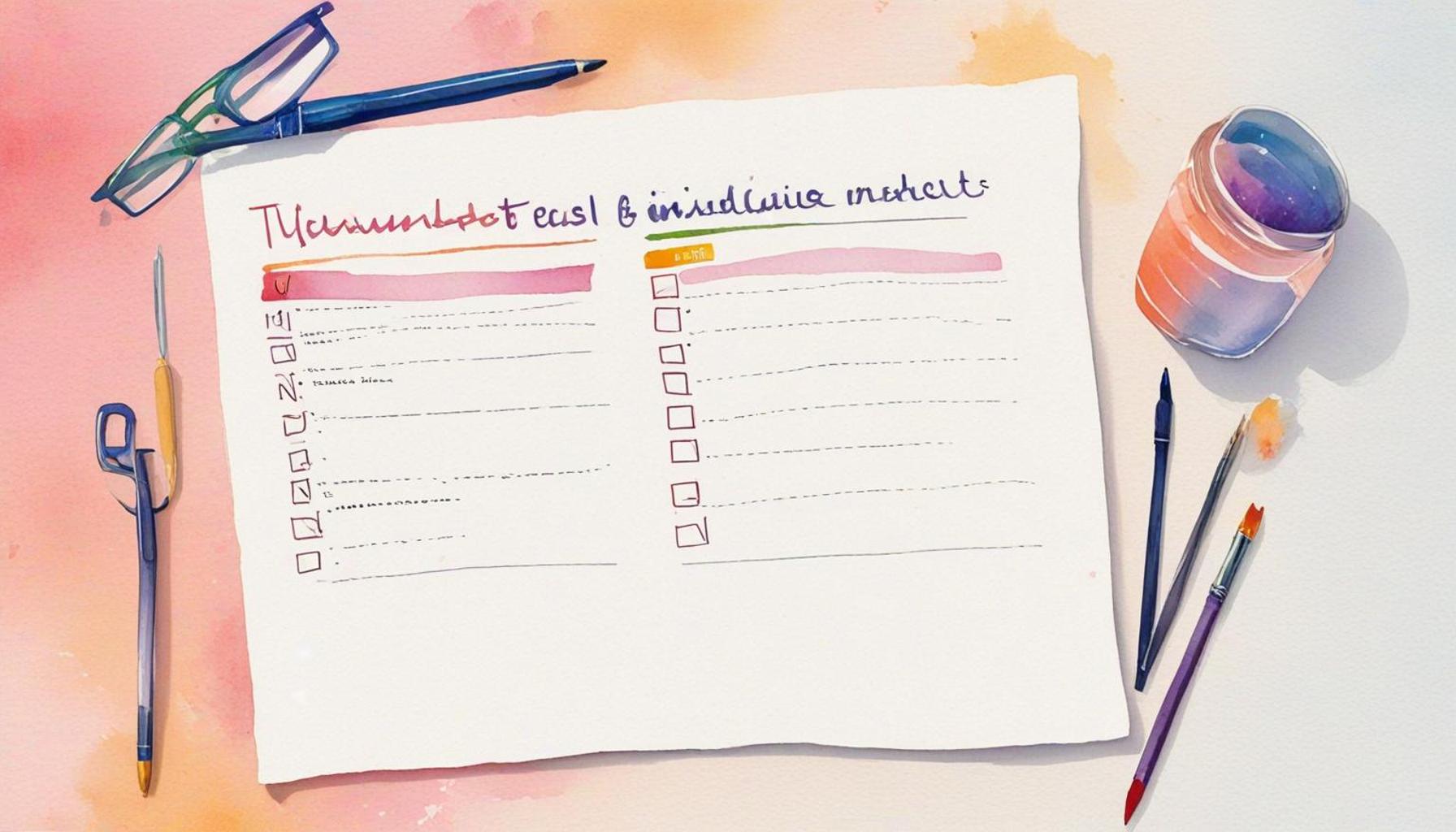Minimalism and Time Management: Techniques to Reduce Task Overload

Understanding the Intersection of Minimalism and Time Management
In today’s fast-paced world, overwhelming task overload is a common hurdle many professionals face. The relentless demands of work, social commitments, and personal goals can quickly lead to burnout. Navigating through this chaos can seem daunting, but there are effective strategies to help individuals reclaim their time and energy.
One powerful approach lies in the principles of minimalism, which encourages simplifying life by eliminating the unnecessary. The minimalist philosophy can reduce the clutter not only in our physical spaces but also in our mental landscapes, allowing individuals to focus on priorities. By embracing minimalism, one can discover a clearer path to productivity, especially when combined with sound time management techniques. Here are some key concepts to consider:
- Decluttering Tasks: Begin by removing non-essential tasks from your to-do list. This means looking at everything on your agenda and asking whether each task truly contributes to your goals. For example, if attending weekly meetings is taking up valuable time without providing substantial benefit, consider reducing their frequency or proposing a more effective structure.
- Prioritization: Focus on what truly matters in your personal and professional life. Utilizing a method like the Eisenhower Matrix can be instrumental here. By sorting tasks into categories such as urgent and important, you can identify which tasks deserve your immediate attention and which can be delegated or eliminated altogether.
- Batching Tasks: Group similar tasks to reduce cognitive load and increase efficiency. For instance, instead of switching between different types of work throughout the day, dedicate specific blocks of time for emails, brainstorming, or meetings. This focused approach not only enhances productivity but also reduces stress by minimizing constant task-switching.
The synergy between minimalism and time management can pave the way for a more productive and fulfilling life. By adopting these techniques, you may find it easier to navigate daily responsibilities while leaving room for what matters most. The simplicity that comes with minimalism relieves the mental strain associated with juggling numerous obligations, essentially providing a clearer lens through which to view your activities and commitments.
Embarking on this journey not only addresses the issue of task overload but also opens doors to newfound clarity and freedom. Many professionals who have adopted these principles report feeling more accomplished and energized. Are you ready to learn more about actionable strategies that can transform your approach to time management? By integrating minimalism into your daily routines, you could discover a more balanced and fulfilling lifestyle that prioritizes well-being above relentless busyness.
DIVE DEEPER: Click here for effective decluttering tips

Effective Strategies for Embracing Minimalism in Time Management
As the modern workforce grows increasingly complex, individuals often find themselves trapped in an endless cycle of tasks that leave little room for personal growth or leisure. Amid this chaos, minimalism offers a refreshing perspective on how to manage both time and responsibilities. By applying minimalist philosophies to time management, one can streamline tasks and create a more manageable lifestyle.
Understanding that not all tasks hold equal weight is the first step towards reducing task overload. Here are several strategies to help you embrace a minimalist approach to managing your time effectively:
- Establishing Clear Boundaries: One of the keystones of minimalism is learning to say no. Creating boundaries around your work hours and personal time can significantly impact your productivity. For example, if you find yourself frequently staying late at work, consider setting a specific time to wrap up your tasks each day. This not only helps maintain a healthier work-life balance but also encourages you to prioritize more efficiently during your working hours.
- Utilizing Technology Wisely: In an age where technology can either overwhelm us or empower us, using the right tools can be a game changer. Productivity apps designed to streamline tasks – like Todoist or Trello – can help you focus on essential activities, thereby minimizing distractions. Make a habit of reviewing these tools weekly to ensure you’re only tracking what truly matters. This intentional curation of digital tools reflects the core minimalism concept of eliminating the excess.
- Time Blocking: This technique involves dividing your day into distinct blocks allocated for specific activities. By prioritizing tasks within these time frames, you can reduce the inefficiencies associated with multitasking. For example, if your mornings are typically more productive, consider reserving them for your most demanding work tasks, while designating the afternoons for meetings and collaborative projects. Over time, this structured approach can significantly enhance your productivity and focus.
- Regular Review and Reflection: Take time each week to review your accomplishments and reassess your priorities. Reflecting on what worked well and what didn’t allows you to refine your approach continually. By eliminating outdated objectives and keeping your to-do list current, you align your daily tasks with your larger goals, fostering a mindset of continual improvement inherent in minimalist practices.
The union of minimalism and time management creates a transformative experience that can lessen feelings of overwhelm and confusion often associated with busy lifestyles. By adopting these strategies, you not only simplify your task list but also create the mental space to engage in more meaningful activities. Embracing minimalism can turn chaotic schedules into a harmonious balance, enabling you to focus on what truly matters.
Ultimately, practicing these techniques is not just about reducing tasks; it’s about fostering a mindset that values quality over quantity. Are you ready to take the plunge into a life where you manage your time with intention and purpose? Discovering the art of minimalism within your time management approach could unveil a pathway to greater fulfillment and peace of mind.
Exploring Minimalism in Time Management
In the fast-paced world we inhabit, the pursuit of minimalism can become a transformative practice for enhancing productivity and achieving a balanced life. By focusing on what truly matters, individuals can significantly reduce task overload. This philosophy encourages the identification of core responsibilities and eliminating superfluous tasks that clutter our schedules and minds.
The Benefits of Time Blocking
One effective technique connected to both minimalism and effective time management is time blocking. By segmenting the day into dedicated periods for specific tasks, individuals can maintain focus and avoid the pervasive distractions that contribute to feeling overwhelmed. This method promotes a structured yet flexible approach, allowing for adjustment according to shifting priorities, ultimately leading to a more productive day.
Digital Decluttering: A Must
To complement the principles of minimalism, the practice of digital decluttering is essential. This involves organizing files, reducing unnecessary subscriptions, and minimizing digital distractions that eat away at valuable time. By creating a streamlined digital environment, users can enhance their time management skills, leading to improved efficiency and a more serene workspace.
| Category | Benefits |
|---|---|
| Enhanced Focus | By adopting a minimalist approach, distractions are minimized, allowing for better concentration on tasks. |
| Reduced Stress Levels | A clearer schedule and fewer distractions lead to a calmer mindset and improved decision-making. |
Incorporating these practices not only addresses the overload of tasks we face but also encourages a more meaningful engagement with our work and life, ultimately propelling us toward success and fulfillment. Embracing minimalism in time management opens doors to new possibilities and outcomes.
DISCOVER MORE: Click here for effective home decluttering tips
Implementing Mindfulness in Time Management
Integrating mindfulness into your time management practices can elevate your ability to prioritize effectively and reduce feelings of overwhelm. Mindfulness encourages a deeper awareness of your thoughts and actions, enabling you to respond to your tasks with intention rather than merely reacting impulsively. Here’s how you can utilize mindfulness to enhance your minimalist approach:
- Daily Mindfulness Practices: Start each day with a brief mindfulness exercise, such as meditation or deep breathing. This can help clear your mind, making room for focus on essential tasks. Just ten minutes of quiet reflection can recalibrate your mental state and improve your efficiency in tackling your to-do list.
- Focused Task Execution: When engaging in tasks, commit to single-tasking rather than multitasking. Research shows that multitasking can reduce productivity by up to 40%. By dedicating your full attention to one task at a time, you can complete it more efficiently and with higher quality, in line with minimalist principles. Try using the Pomodoro Technique, where you work in concentrated bursts followed by short breaks, to sustain focus and prevent burnout.
- Gratitude Journaling: Keep a gratitude journal as part of your evening routine. Reflecting on your accomplishments and expressing gratitude for what you’ve achieved can create a positive mindset. This practice supports time management by helping you to recognize the value of your efforts and adjust your task priorities for the following day based on what genuinely brought you satisfaction.
Prioritization Techniques to Simplify Your Task List
Not all tasks are created equal. Employing effective prioritization techniques can drastically simplify your workload while maintaining productivity. The Eisenhower Matrix, for instance, categorizes tasks based on urgency and importance. Tasks can fall into one of four quadrants: urgent and important, important but not urgent, urgent but not important, and not urgent and not important.
This structured approach encourages you to focus on what genuinely matters while identifying tasks that can either be delegated or eliminated. By eliminating unnecessary tasks from your schedule, you create a more streamlined day that values only what contributes to your overarching goals.
- The Two-Minute Rule: If a task will take two minutes or less to complete, do it immediately, rather than adding it to a list. This rule can drastically reduce the number of small tasks that clutter your mind and workload, allowing greater mental clarity.
- Set SMART Goals: Ensure your objectives are Specific, Measurable, Achievable, Relevant, and Time-bound. Break larger goals into smaller, actionable steps. This not only clarifies your priorities but also makes your tasks feel more manageable, providing quick wins that motivate you to continue.
Creating a Conducive Environment for Minimalism
Your physical environment plays a crucial role in your mental capacity to manage time effectively. A clutter-free workspace cultivates a sense of calm and focus. Begin by decluttering your desk and minimizing distractions. Simple changes like organizing digital files, limiting notifications on devices, or creating a dedicated workspace can have profound effects on your productivity.
Moreover, consider instituting a ‘clean desk policy’ at the end of each workday. By leaving your workspace tidy, you create a sense of closure, helping to establish boundaries between work and personal time. This ritual not only reinforces minimalism but also positively influences your time management capacity.
Implementing these techniques not only simplifies your day-to-day functions but also aids in creating a sustainable, enjoyable rhythm in life. In the fast-paced U.S. work environment, understanding minimalism as a form of time management can be the key to unveiling a more fulfilling lifestyle. By prioritizing what matters and fostering mindfulness, you can reclaim time previously wasted on trivial tasks, leading to a more enriched and intentional life.
DISCOVER MORE: Click here to learn effective organization strategies
Conclusion
In today’s fast-paced world, where distractions abound and the pressure to perform is ever-increasing, embracing a minimalist approach to time management is more essential than ever. By incorporating mindfulness, prioritization techniques, and a conducive workspace, we can significantly combat the feelings of task overload that often paralyze productivity.
The key takeaway is that less truly can be more. Through practices like single-tasking and utilizing the Eisenhower Matrix, we can streamline our goals and focus on what genuinely contributes to our success. Implementing small, actionable strategies like the Two-Minute Rule allows us to diminish mental clutter, paving the way for enhanced clarity and efficiency. Furthermore, cultivating a habit of gratitude helps maintain motivation, celebrating our accomplishments and fostering a positive mindset.
As we work to build a life filled with purpose and intention, we must also remember that our physical environment can either support or hinder our efforts. A well-organized space promoting minimalism can lead to clearer thinking, ultimately improving our time management capabilities.
With the combination of these techniques, we can reclaim our time, reduce stress, and design a fulfilling life that aligns with our values and aspirations. By assessing our priorities and gradually eliminating unnecessary tasks, we not only enhance our productivity but also nurture a greater sense of well-being. So, embark on this journey of minimalism in time management and watch as you transform your daily experiences into a more enriched, focused, and meaningful existence.



